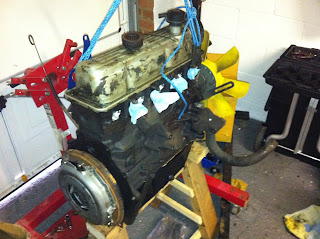Fuel Pump
The first weekend I tried to start the engine failed before it really got going! Mike & I started by removing the rocker cover to investigate the valve placement at camshaft TDC; all looked good but we suspected there was a misalignment with the crank. Didn't think it was too bad and not bad enough to get the engine started. So, chug chug chug with the starter and nothing...............not even a drop of fuel in the filters. The starter turned, the engine turned but there was a fuel issue. The engine was originally an injection model, I've stuck it to carbs with a mechanical fuel pump - the trouble here was that I didn't have the small push rod that is required to pump the pump.
Thanks to a very helpful Locost member who sourced the part and sent it to me. Fitted, problem solved but still no fire!
Electrical
I stuck a post up on Rhocar asking for a bit of advice, I was fortunate enough to have Alan_builder living very close by. He came over and we worked through the ignition electrics to determine that there was a spark and enough power to, in theory, get it started. After fixing a loose connection on the dizzy, setting the timing on the crank and dizzy we then tried the engine - still nothing. A few more tests on the leads and plugs, we were in agreement that the spark plugs were rubbish.
A few days later, I had new plugs and was able to create a better spark. However still no luck on the engine!!
Weber 32/36 DGV Carb
Wtih a second visit by Alan and a useful post on Rhocar by Longboarder, we determined that my carb was also causing issues. My carb had an anti-dieseling valve which wasn't connected up to the live, however once connected we discovered that it was damaged beyond repair. The purpose of this part is to stop fuel getting into the engine if the power is cut, sounds an ideal part however mine was broke!! £45 for a replacement, bit steep so I bought a second hand Weber 32/36 DGAV and this seems to be OK.
Timing
As mentioned above, there was a suspicion of a timing issue between the crank and cam, this was true and as all other avenues had been explored I thought I should follow up on this. Crank turned to TDC, timing belt slackened, cam turned the shortest possible direction to line up with TDC and dizzy lined up. I tightened up the belt tensioner, checked the dizzy (about 8 deg before TDC), turned the engine to check it stayed lined up and then took the plunge - it started!!!!!!!
Now, the engine starting was a huge milestone, it was the first time I had ever heard it running and coincided with the 1st anniversary (give or take a few days) since I collected the kit from GBS. However it did highlight a few issues that need to be resolved before I can run the engine for a longer period:
Smoke on Engine Block
There was a small amount of smoke coming from near the top of the exhaust manifold, not apparent in the video but visible to me stood next to it!! Will investigate this but not a urgent issue.
Oil Pressure Light
This didn't switch off as expected, not sure if this was due to the leak I later found or if there is a fault with the old Ford switch or my wiring. Stupidly I forgot to look at the oil pressure gauge I had paid good money to show up if there is an oil pressure issue!! One for the future.
Oil Leak
Looks like there is a leak coming from the rocker cover, I might have not tightened the bolts properly so I will follow up on this. It was a new gasket so might need bedding in. One to think about.
Doesn't switch off!
The biggest issue that I found after starting the engine - it doesn't switch off!! I have a feeling there might be a wiring issue linked to the alternator that keeps the ignition coil live despite the key being switched off and even taken out of the car. I had to stop the engine by removing the ht leads. This is a very odd issue but one that will be solved by understanding the entire wiring loom - hopefully! Think I might give GBS a ring on this one before I mess around too much.











































